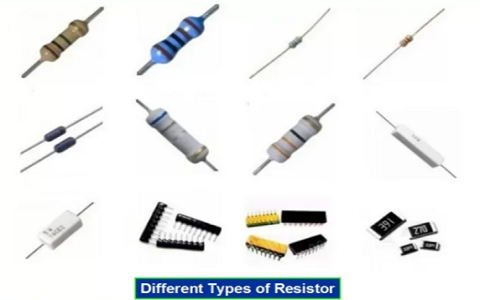What is a Resistor | Types of Resistor, Function, Color Code, Symbol
Here we Learn What is a Resistor – Different Types of Resistor, their Function, Color Code, Symbol, Examples and Application Explained in Detail.
What is a Resistor?
A Resistor is an electrical device that resists the flow of electrical current. It is a passive device used to control, or impede the flow of, electric current in an electric circuit by providing resistance, thereby developing a drop in voltage across the device.
We need some way to control the flow of current from a voltage source, like a battery, so we do not melt wires and blow up batteries.
If you think of current, charge flow, in terms of water flow, a good electrical conductor is like big water pipe. Water mains and fire hoses have their uses, but you do not want to take a drink from one. Rather, we use small pipes, valves, and other devices to limit water flow to practical levels.
Resistors do the same for current; they resist the flow of charge; they are poor conductors.
How is a Resistor Made?
There are many different ways to make a resistor. Some are just a coil of wire made of a material that is a poor conductor.
The most common and inexpensive type is made from powdered carbon and a glue-like binder.

Resistance Materials
Resistors are made from a number of different materials. I shall only concentrate on the most common varieties, and the attributes I have described for each are typical – there will be variations from different makers, and specialized types that don’t follow these (very) basic characteristics. All resistors are comparatively cheap.
1. Carbon Composition
Low to medium power. Comparatively poor tolerance and stability. Noisier than most others.
2. Carbon Film
Low power. Reasonable tolerance and stability. Reasonably quiet.
3. Metal Film
Low to medium power. Very good tolerance and stability. Quiet.
4. Wirewound
High to very high power. Acceptable to very good tolerance, good stability. Quiet. May have inductance.
Resistors make noise. Everything that is above 0K (zero Kelvin, absolute zero, or -273 degrees Celsius) makes noise, and resistors are no exception. Noise is proportional to temperature and voltage. Low noise circuits will always use low resistor values and low voltage wherever possible.
Resistors may also have inductance, and Wirewound types are the worst for this. There are non-inductive Wirewound resistors, but are not readily available, and usually not cheap.
What is a Potentiometer?
A potentiometer is a variable resistor. When the knob of a potentiometer is turned, a slider moves along the resistance element.
Potentiometers generally have three terminals, a common slider terminal, and one that exhibits increasing resistance and one that has decreasing resistance relative to the slider as the shaft is turned in one direction.
The resistance between the two stationary contacts is, of course, fixed, and is the value specified for the potentiometer. The photo resistor or photocell is composed of a light sensitive material. When the photocell is exposed to more light, the resistance decreases. This type of resistor makes an excellent light sensor.

